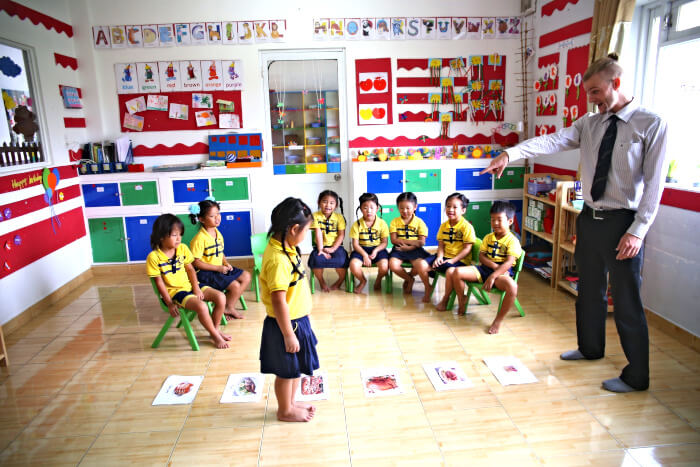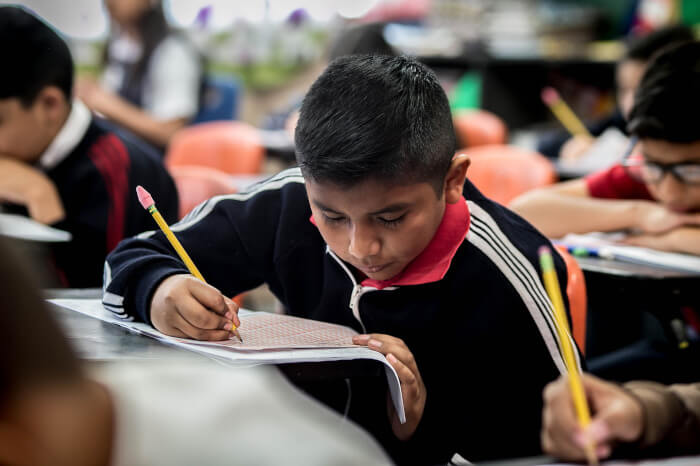We all know that students learn individually in addition to learning with others. But for students to learn from and with each other, they need to have a basic and shared understanding of the content.
A flipped classroom brings the application of learning into the classroom and has students develop an initial understanding outside of the classroom on their own time, through readings or pre-recorded lectures. For example, you might be trying to create a group project or have students work on a science lab together. The flipped classroom supports student learning because they get to apply the things they’ve learned in the presence of their teacher instead of at home or during a study hall.
Let’s take a look at how you can flip your classroom (and why you might want to consider doing so).
What is a flipped classroom?
A flipped classroom differs from a traditional classroom because students complete the applied learning activities in the classroom and view lectures or complete readings at home. It’s not enough to assign readings for homework and put students in groups and expect the classroom to work perfectly — in short, having a successful flipped classroom is hard. It does not make teaching easier, nor does it diminish the role of the teacher.
This article will provide you with helpful tips to prepare you for flipping your classroom.
8 ways to create a flipped classroom

1. Remember to differentiate your instruction
Students in your class are going to be at different levels of readiness with their learning. When you’re deciding on the materials that should be covered outside of class, make sure to match them to the needs and abilities of your students. In the classroom, you can also create groups that will create a positive learning environment for the students by considering their individual abilities and demeanors.
Classcraft Quests are a great option when considering how to differentiate your instruction. You can create varied learning paths that accelerate some students and provide extra support to others. These quests can have built-in assignments. A quest is a great example of being able to build seamless connections between in-class and out-of-the-classroom learning because student can continue their quest from anywhere with an internet connection.

2. Adapt your approach to your classroom
There are valid arguments in favor of giving no homework. This notion seems to be at odds with that of a flipped classroom, where out of classroom learning is expected. When deciding on the activities that will be completed outside of classroom hours, make sure that students are able to actually complete them. If your students have a home life that prevents them from normally completing homework assignments, then consider a modified flipped classroom.
To create a modified flipped classroom, you can sequence the classroom activities, where students watch lectures or complete readings in one class period and then work on applied learning in the next class meeting. This strategy helps you to facilitate the group learning where students have ownership of their learning while at the same time ensuring that students have the required background information to make sense of the applied learning activities.

3. Prepare for growing pains
A flipped classroom might be new for your students as well. It can take time to adjust to a different sequence and approach to learning. As you evolve in your teaching, you’ll learn new strategies that you did not know the first day of implementing your flipped classroom.
Whenever you notice new activities, decisions, or strategies that work really well, write them down. This will allow you to reflect on this progress and make it more effective in the future.

4. Be intentional in the classroom
If you’ve traditionally set up your classroom where you spend a majority of the time instructing or leading students in discussion, then it can be awkward to be a teacher in the flipped classroom. It might seem like you do not have much to do because students are learning from each other and on their own.
However, the applied learning activities will be much richer with input and leadership from the teacher. In a flipped classroom, think of yourself more as a facilitator and less as a speaker. This is where the notion of shifting from “sage on the stage” to “guide on the side” is especially relevant. In the flipped classroom, you will need to spend a lot of time scaffolding activities, building in prompts and discussions, and identifying areas where learning can be interrupted for additional explanation or elaboration.
In addition to the time spent creating activities, you also need to decide how students will learn in social settings and how the groups will be structured. To that end, you can consider using tools such as CATME to create groups with specific purposes.

5. Use technology with purpose
Technology is ubiquitous — many of your students have their own phones, most schools have at least one set of computers, and one-to-one technology initiatives happen with regularity. This means that it’s easy to incorporate technology into learning without putting in much thought. However, using technology with purpose has the potential to create a lot more value in student learning.
If you carefully consider each learning activity and take time to design your lesson before adding in any relevant technology, then the technology will naturally complement the learning. This differs from how technology is normally used, where it’s chosen first and then the activities or assignments are built around it.

6. Ask and network
Despite the resources available online, many of us still network and ask our peers for ideas or feedback. And when it comes to flipping the classroom, things are no different. Is there an educator in your school or district that has already done this successfully? If not, can you identify a leader in organizations or conferences who can provide evidence of the flipped classroom working well?
But don’t only think about yourself. Could you also build in networking or learning opportunities for your students? Can you take your students to another classroom and have them watch a flipped learning classroom in action? If not, can you set up a virtual field trip where they watch from a distance? After these trips, you could have a discussion with your students about what they saw in the flipped classroom that made it effective. This can help to create ownership of the shift in learning and reduce possible frustrations or issues down the road.

7. Assess individual learning
A flipped classroom means that students are doing most of their individual work outside of the classroom. This can lead a teacher to almost forget about the learning that is occurring. However, it is important to assess what students are learning on their own. Doing so can help you as a teacher plan future assignments and give insight into what each individual student is retaining from the lessons and materials.
In the flipped classroom, you can create formative assessments to assess individual knowledge or have students write their own blogs or prepare presentations for class. For a larger assignment, you could even have students teach a concept or idea to the class.
8. Balance group learning
There are endless variations on group learning. You could have whole group activities or small group activities. In those groups, you could have case studies, debates, think-pair-shares, shared reading, and many other activities. Try to balance and vary the group learning activities you use. If you incorporate too many activities, it may be hard for students to get into the flow of what to expect with their classroom learning. Alternatively, if you only use a couple, then students may get bored with the activities.
You could even involve your students in this decision. Are there two or three group learning activities that are similar in their goals and outcomes? If so, you could ask students for their opinions on which ones they enjoy the most. You could also switch up these activities according to the specific unit or subject that you’re teaching. For example, does one type of group activity work better for science than for reading? If so, use it where it makes sense.
A flipped class gives students control over their learning
A flipped learning classroom empowers students and gives them control of their learning. However, the decision to implement a flipped classroom is complex and requires careful consideration. If you decide that this is a good option for your classroom, take the time to plan the transition from a traditional classroom to a flipped one. You could even start with a small pilot in one subject area before completely changing the structure of your classroom.
Hopefully, this article provided you with some helpful tips and strategies to better prepare you to flip your classroom. Good luck!
Photo credit: TheoRivierenlaan; NgoHuuMoi; facethebook; epollato0; sonconaz97; delphoma; rawpixel; ernestoeslava / Pixabay.com
Personalized Learning


